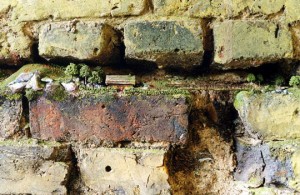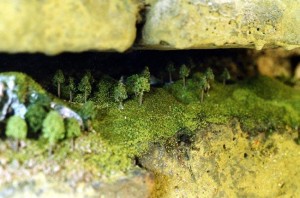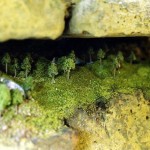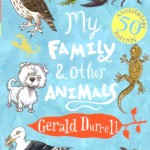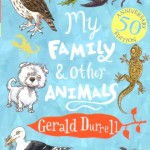Tot veient diverses instal·lacions, intervencions urbanes i land art, em van suggerir un text de Gerald Durrel del llibre “La meva família i altres animals”, que encaixava perfectament amb una imatge de l’artista Helen Nodding dins del projecte Hideaway.
En aquesta imatge, com en alguna altra intervenció, podem veure el joc d’escales, i entendre aquesta petita escletxa com tot un paisatge. Llegiu aquests text de Durrell, en versió original en anglès i amb traducció al castellà. Podreu tenir el plaer de trobar una interessant descripció i una riquesa de vocabulari extraordinària . Us recomano aquest llibre, que he llegit a partir de l’ interès que aquests paràgrafs em van despertar.
Àngels Pradilla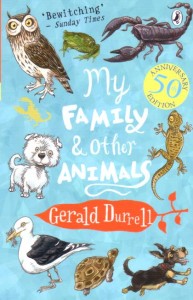
CHAPTER NINE
The World in a Wall
The crumbling wall that surrounded the sunken garden alongside the house was a rich hunting ground for me. It was an ancient brick wall that had been plastered over, but now this outer skin was green with moss, bulging and sagging with the damp of many winters. The whole surface was an intricate map of cracks, some several inches wide, others as fine as hairs. Here and there large pieces had dropped off and revealed the rows of rose-pink bricks lying beneath like ribs. There was a whole landscape on this wall if you peered closely enough to see it; the roofs of a hundred tiny toadstools, red, yellow, and brown, showed in patches like villages on the damper portions; mountains of bottle-green moss grew in tuffets so symmetrical that they might have been planted and trimmed; forests of small ferns sprouted from cracks in the shady places, drooping languidly like little green fountains. The top of the wall was a desert land, too dry for anything except a few rust-red mosses to live in it, too hot for anything except sun-bathing by the dragon-flies. At the base of the wall grew a mass of plants, cyclamen, crocus, asphodel, thrusting their leaves among the piles of broken and chipped roof-tiles that lay there. This whole strip was guarded by a labyrinth of blackberry hung, in season, with fruit that was plump and juicy and black as ebony.
The inhabitants of the wall were a mixed lot, and they were divided into day and night workers, the hunters and the hunted. At night the hunters were the toads that lived among the brambles, and the geckos, pale, translucent with bulging eyes, that lived in the cracks higher up the wall. Their prey was the population of stupid, absent-minded crane-flies that zoomed and barged their way among the leaves; moths of all sizes and shapes, moths striped, tessellated, checked, spotted, and blotched, that fluttered in soft clouds along the withered plaster; the beetles, rotund and neatly clad as business men, hurrying with portly efficiency about their night’s work. When the last glow-worm had dragged his frosty emerald lantern to bed over the hills of moss, and the sun rose, the wall was taken over by the next set of inhabitants. Here it was more difficult to differentiate between the prey and the predators, for everything seemed to feed indiscriminately off everything else. Thus the hunting wasps searched out caterpillars and spiders; the spiders hunted for flies; the dragon-flies, big, brittle, and hunting-pink, fed off the spiders and the flies; and the swift, lithe, and multicoloured wall lizards fed off everything.
El mundo en un muro
El muro ruinoso que rodeaba el jardín hundido contiguo a la casa era para mí un rico coto de caza. Era una tapia antigua de ladrillos en otro tiempo enlucida, pero ahora aquella epidermis aparecía verde de musgo, levantada y combada por la humedad de muchos inviernos. La superficie entera era un mapa intrincado de grietas, unas de varios centímetros de anchura, otras del grosor de un cabello. Aquí y allá se habían desprendido fragmentos grandes de yeso, dejando al descubierto el costillar de rosados ladrillos. Visto de cerca, el muro constituía todo un paisaje: los tejadillos de cientos de hongos diminutos, rojos, amarillos y marrones, se arracimaban como pueblecitos en las partes más húmedas; las montañas de musgo verde botella crecían en bandas tan simétricas que diríanse haber sido plantadas y recortadas; de los puntos más sombreados de las grietas brotaban bosques de pequeños helechos, inclinándose lánguidos como arroyos de verdor. La zona alta del muro era tierra desértica, tan reseca que sólo nutría unos cuantos musgos rojizos, tan caliente que sólo servía de solana para las libélulas. Al pie crecía un amasijo de plantas: crocos, ciclámenes, asfódelos, que asomaban sus hojas por entre los montones de tejas rotas y melladas. Protegía toda esta parte un laberinto de zarzamoras moteadas, en estación, de fruta gruesa y jugosa, negra como el ébano.
Los habitantes de este muro formaban un conjunto variopinto, dividido en trabajadores diurnos y nocturnos, cazadores y cazados. De noche los cazadores eran los sapos que vivían entre las zarzas, y las salamanquesas pálidas y translúcidas de ojos saltones que habitaban en las rendijas de más arriba. Su presa era la población de típulas tontas, despistadas, que circulaban zumbando entre el follaje; las mariposas nocturnas de infinitas formas y tamaños, mariposas a rayas, a cuadros, jaspeadas, listadas, atigradas, que revoloteaban en blandas nubes junto al yeso marchito; y los escarabajos rechonchos, impecables como hombres de negocios, que corrían con obesa eficiencia a sus tareas nocturnas. Cuando ya la última luciérnaga había cruzado las colinas de musgo para meter en cama su linterna esmeralda, y salía el sol, el muro era invadido por el siguiente grupo de habitantes. Aquí era más difícil distinguir al cazador de su presa, pues cada uno parecía alimentarse indiscriminadamente de todos los demás. Así, las avispas depredadoras buscaban orugas y arañas; las arañas cazaban moscas; las grandes, quebradizas y rosadas libélulas se nutrían de arañas y de moscas; y las veloces lagartijas, esbeltas y multicolores, se alimentaban de todo en general.
Traducción Maria Luisa Balseiro / Alianza Editorial, Madrid

